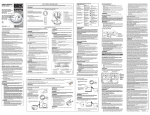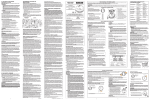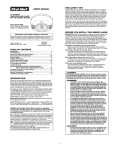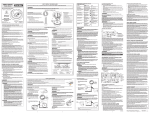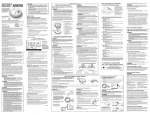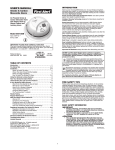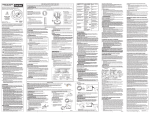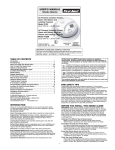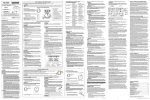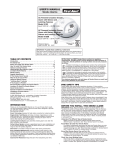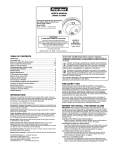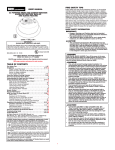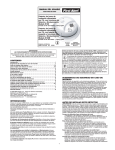Transcript
IF THIS SMOKE & STROBE LIGHT ALARM SOUNDS
ABOUT SMOKE ALARMS
RECOMMENDED PLACEMENT
RESPONDING TO AN ALARM
During a smoke incident at this alarm, you will hear a loud repeating horn
pattern: 3 beeps, pause, 3 beeps, pause and the strobe light will flash
constant approximately 1 flash per second.
Note: If you have interconnected this alarm with a BRK carbon monoxide
alarm or combination smoke & carbon monoxide alarm, when there is
a carbon monoxide incident you will hear a loud repeating horn pattern
from this alarm: 4 rapid beeps, pause, 4 rapid beeps, pause. In addition,
the strobe light will intermittently flash approximately 1 flash per second
for four flashes, then 5 seconds off. The pattern is repeated.
If you have interconnected this alarm with a BRK smoke alarm, heat
alarm or a combination smoke & carbon monoxide alarm, when there is
a smoke incident you will hear a loud repeating horn pattern from this
alarm: 3 beeps, pause, 3 beeps, pause and the strobe light will flash
constant approximately 1 flash per second.
• If the unit alarms and you are not testing the unit, it is warning you of a
potentially dangerous situation that requires your immediate attention.
NEVER ignore any alarm. Ignoring the alarm may result in injury or
death.
• Never disconnect the AC power to quiet an unwanted alarm.
Disconnecting the power disables the Alarm so it cannot sense
smoke. This will remove your protection. Instead, open a window or
fan the smoke away from the unit. The Alarm will reset automatically.
• If the unit alarms get everyone out of the house immediately.
• ELECTRICAL SHOCK HAZARD: Attempting to disconnect the power
connector from the unit when the power is on may result in electrical
shock, serious injury or death.
When an interconnected system of AC powered units is in alarm, the alarm
indicator light on the unit(s) that initiated the alarm will blink rapidly. It will
remain OFF on any remaining units.
If the unit alarms, get everyone out of the dwelling immediately.
If the unit alarms and you are certain that the source of smoke is not a fire—
cooking smoke or an extremely dusty furnace, for example—open a nearby
window or door and fan the smoke away from the unit (Use the Silence Feature
to silence the Alarm). This will silence the alarm, and once the smoke clears the
unit will reset itself automatically.
WHAT TO DO IN CASE OF FIRE
•
•
•
•
•
•
•
•
Don’t panic; stay calm. Follow your family escape plan.
Get out of the house as quickly as possible. Don’t stop to
get dressed or collect anything.
Feel doors with the back of your hand before opening them.
If a door is cool, open it slowly. Don’t open a hot door. Keep doors
and windows closed, unless you must escape through them.
Cover your nose and mouth with a cloth (preferably damp).
Take short, shallow breaths.
Meet at your planned meeting place outside your home,
and do a head count to make sure everybody got out safely.
Call the Fire Department as soon as possible from outside.
Give your address, then your name.
Never go back inside a burning building for any reason.
Contact your Fire Department for ideas on making your home safer.
Alarms have various limitations. See "Limitations of Smoke Alarms" for
details.
USING THE SILENCE FEATURES
Never remove the batteries to quiet an unwanted alarm. Removing the
batteries disables the alarm and removes your protection.
The Silence Feature is intended to temporarily silence the horn while you
identify and correct the problem. Do not use the Silence Feature in emergency
situations. It will not extinguish a fire.
The Silence Feature can temporarily quiet an unwanted alarm for several
minutes. You can silence this Alarm by pressing the Test/Silence button on
the alarm cover for at least 3-5 seconds.
After the Test/Silence button is released, the Red LED blinks during the
silence mode.
Battery (DC) operated Smoke Alarms: Provide protection even when electricity
fails, provided the batteries are fresh and correctly installed. Units are easy to
install, and do not require professional installation. They do not, however, provide
interconnected functionality.
AC powered Smoke Alarms: Can be interconnected so if one unit senses smoke,
all units alarm. They do not operate if electricity fails. AC with battery (DC) back-up:
will operate if electricity fails, provided the batteries are fresh and correctly installed.
AC and AC/DC units must be installed by a qualified electrician.
Wireless Interconnected Alarms: Offer the same interconnected functionality as
with hardwired alarms, without wires. Units are easy to install and do not require
professional installation. They provide protection even when electricity fails, provided
the batteries are fresh and correctly installed.
STROBE LIGHT OUTPUT FOR WALL & CEILING MOUNTING
The intensity of the strobe light gradually lessens as the angle increases. In other
words, the light is brightest directly in front of the strobe light and is progressively
less bright to either side. As required by Underwriters Laboratories Inc. (UL), the
following illustrations show how the strobe light is dispersed. Use them to help you
choose where to locate units for the hearing impaired.
CEILING
LIGHT
90
90
45
45
0
FIGURE 1: Light Output
for Ceiling Mount
Angle
(In Degrees)
Percent
Light Intensity
0
5-25
30-45
50
55
60
65
70
75
80
85
90
100
90
75
55
45
40
35
35
30
30
25
25
90
WALL
0
LIGHT
45
FIGURE 2: Light Output
90
for Wall Mount
PHOTOSENSITIVE EPILEPSY AND STROBE FLASH RATES
Individuals who are susceptible to photosensitive epilepsy might have an increased
probability for seizures with multiple strobe lights flashing asynchronously. The
frequency or speed of flashing light that is most likely to cause seizures varies
from person to person. Generally, flashing lights most likely to trigger seizures are
between the frequency of 5 to 30 flashes per second (Hertz). This strobe light
flashes at about 1 flash per second.
Under the Americans with Disabilities Act, most workplaces and places serving the
public, including theaters, restaurants, and recreation areas, are required to have
fire alarms, which flash as well as ring so that people who cannot hear or cannot
hear well will know that there is an emergency.
RECOMMENDED LOCATIONS FOR
SMOKE ALARMS
Installing Smoke Alarms in Single-Family Residences
The National Fire Protection Association (NFPA), recommends one Smoke Alarm on
every floor, in every sleeping area, and in every bedroom. In new construction, the
Smoke Alarms must be AC powered and interconnected. See “Agency Placement
Recommendations” for details. For additional coverage, it is recommended that
you install a Smoke Alarm in all rooms, halls, storage areas, finished attics, and
basements, where temperatures normally remain between 40˚ F (4.4˚ C) and 100˚ F
(37.8˚ C). Make sure no door or other obstruction could keep smoke from reaching
the Smoke Alarms.
More specifically, install Smoke Alarms:
• On every level of your home, including finished attics and basements.
• Inside every bedroom, especially if people sleep with the door partly or
completely closed.
• In the hall near every sleeping area. If your home has multiple sleeping areas,
install a unit in each. If a hall is more than 40 feet long (12 meters), install a unit
at each end.
• At the top of the first-to-second floor stairway, and at the bottom of the
basement stairway.
Specific requirements for Smoke Alarm installation vary from state to state and
from region to region. Check with your local Fire Department for current requirements in your area. It is recommended AC or AC/DC units be interconnected
for added protection.
The Smoke Alarm will remain silent for up to 15 minutes, then return to
normal operation.
If the smoke has not cleared–or continues to increase–the device will go
back into alarm.
SILENCING THE LOW BATTERY WARNING
This Silence Feature can temporarily quiet the low battery warning “chirp” for
up to 8 hours if AC/DC power is present. Press the Test/Silence button on the
Alarm cover until you hear the acknowledge “chirp”.
Once the low battery warning “chirp” silence feature is activated, the unit
continues to flash the green light once a minute for 8 hours. After 8 hours, the
low battery “chirp” will resume. The Alarm will continue to operate as long as
AC power is supplied. However, replace the batteries as soon as possible,
to maintain protection in event of a power outage.
To deactivate this feature: Press the Test/Silence button again. The unit will
go into Test Mode and the low battery warning will resume (LED flashes and
unit sounds “chirp” once a minute).
LATCHING FEATURES
Alarm Latch is activated after an Alarm is exposed to alarm levels of smoke.
This feature will only work with AC power. After smoke levels drop below alarm
levels, the Red LED will begin to flash once every few seconds. It will continue
to flash or “latch” until you clear it by testing the alarm.
This feature helps emergency responders, investigators, or service technicians
identify which unit(s) in your home were exposed to alarm levels of smoke.
This can help investigators pinpoint the source of smoke.
The Latching Alarm Indicator stays ON until you clear it, so it can alert you to
an alarm that occurred while you were away from home, even though smoke
present in the air has dropped below alarm levels.
Low Battery Latch is activated when the Alarm is in the "low battery
condition". When this occurs, the LED flashes Green On for 2 seconds/Off
for 2 seconds. This feature is designed to help you identify which Alarm
needs to have the battery replaced. Although, the Alarm will sound the low
battery chirp approximately once every minute, sometimes during the initial
stages of "low battery", the Alarm will chirp in greater intervals than one
minute, sometimes up to several hours, until the battery reaches a steady
low battery level. This innovative feature eliminates the frustration of waiting
for and/or identifying which unit is chirping.
“SMART INTERCONNECT” FEATURE
This Alarm includes "Smart Interconnect" which enables the Alarm to be
interconnected with other First Alert® and BRK Smoke, Heat, and "Smart
Interconnect" CO Alarms. When smoke is detected, all Alarms will sound
the smoke horn pattern. When CO is detected, "Smart Interconnect" Alarms
will sound the CO horn pattern. Alarms that do not have the "Smart
Interconnect" feature will remain silent during a CO alarm.
AGENCY PLACEMENT RECOMMENDATIONS
NFPA 72 Chapter 29
“For your information, the National Fire Alarm and Signaling Code, NFPA 72,
reads as follows:”
29.5.1* Required Detection.
29.5.1.1* Where required by other governing laws, codes, or standards for a
specific type of occupancy, approved single and multiple-station smoke alarms
shall be installed as follows:
(1)*In all sleeping rooms and guest rooms
(2)*Outside of each separate dwelling unit sleeping area, within 21 ft (6.4 m) of any
door to a sleeping room, with the distance measured along a path of travel
(3) On every level of a dwelling unit, including basements
(4) On every level of a residential board and care occupancy (small facility),
including basements and excluding crawl spaces and unfinished attics
(5)*In the living area(s) of a guest suite
(6) In the living area(s) of a residential board and care occupancy (small facility)
(Reprinted with permission from NFPA 72®, National Fire Alarm and Signaling Code
Copyright © 2010 National Fire Protection Association, Quincy, MA 02269.
This reprinted material is not the complete and official position of the National Fire
Protection Association, on the referenced subject which is represented only by the
standard in its entirety), (National Fire Alarm and Signaling Code® and NFPA 72® are
registered trademarks of the National Fire Protection Association, Inc., Quincy, MA
02269).
California State Fire Marshal (CSFM)
Early warning detection is best achieved by the installation of fire detection equipment
in all rooms and areas of the household as follows: A Smoke Alarm installed in each
separate sleeping area (in the vicinity, but outside bedrooms), and Heat or Smoke
Alarms in the living rooms, dining rooms, bedrooms, kitchens, hallways, finished
attics, furnace rooms, closets, utility and storage rooms, basements, and attached
garages.
LOCATIONS TO AVOID FOR SMOKE ALARMS
IF YOU SUSPECT A PROBLEM
Smoke Alarms may not operate properly because of dead, missing or weak
batteries, a build-up of dirt, dust or grease on the Smoke Alarm cover, or
installation in an improper location. Clean the Smoke Alarm as described in
“Regular Maintenance,” and install a fresh battery, then test the Smoke Alarm
again. If it fails to test properly when you use the test button, or if the problem
persists, replace the Smoke Alarm immediately.
• If you hear a “chirp” approximately once a minute, replace the battery.
• If you experience frequent non-emergency alarms (like those caused
by cooking smoke), try relocating the Alarm.
• If the alarm sounds when no smoke is visible, try cleaning or relocating
the Alarm. The cover may be dirty.
• If the alarm does not sound during testing, make sure it is receiving
AC power from the household current.
Always discharge the branch circuit before servicing an AC or AC/DC
Alarm. First, turn off the AC power at the circuit breaker or fuse box. Next,
remove the battery from Alarms with battery back-up. Finally, press and
hold the test button for 5-10 seconds to discharge the branch circuit.
Do not try fixing the alarm yourself – this will void your warranty!
If the Alarm is still not operating properly, and it is still under warranty, please
see “How to Obtain Warranty Service” in the Limited Warranty.
RECOMMENDED PLACEMENT FOR HEARING
IMPAIRED SMOKE ALARMS WITH INTEGRATED
STROBE LIGHT
Smoke Alarms for the hearing impaired: Special purpose Smoke Alarms should
be installed for the hearing impaired. They include a visual alarm and an audible
alarm horn, and meet the requirements of the Americans With Disabilities Act.
These units can be interconnected so if one unit senses smoke, all units alarm.
Smoke alarms are not to be used with detector guards unless the combination
has been evaluated and found suitable for that purpose.
45
When the Smoke Alarm is Silenced...
To silence Alarms in an interconnected series: To silence an interconnected
series of Smoke/CO Alarms, you must press the Test/Silence button on the
initiating alarm (The unit with the flashing red light; the red light will be off on
all other Alarms.). If you press the Test/Silence on any other Alarm, it will only
silence that unit, not the whole interconnected series.
Smoke Alarms for Solar or Wind Energy users and battery backup power
systems: AC powered Smoke Alarms should only be operated with true or pure
sine wave inverters. Operating this Smoke Alarm with most battery-powered
UPS (uninterruptible power supply) products or square wave or “quasi sine wave”
inverters will damage the Alarm. If you are not sure about your inverter or UPS
type, please consult with the manufacturer to verify.
For best performance, AVOID installing Smoke Alarms in these areas:
• Where combustion particles are produced. Combustion particles form when
something burns. Areas to avoid include poorly ventilated kitchens, garages,
and furnace rooms. Keep units at least 20 feet (6 meters) from the sources of
combustion particles (stove, furnace, water heater, space heater) if possible.
In areas where a 20-foot (6 meter) distance is not possible – in modular,
mobile, or smaller homes, for example – it is recommended the Smoke Alarm
be placed as far from these fuel-burning sources as possible. The placement
recommendations are intended to keep these Alarms at a reasonable distance
from a fuel-burning source, and thus reduce “unwanted” alarms. Unwanted
alarms can occur if a Smoke Alarm is placed directly next to a fuel-burning
source. Ventilate these areas as much as possible.
• In air streams near kitchens. Air currents can draw cooking smoke into the
sensing chamber of a Smoke Alarm near the kitchen.
• In very damp, humid or steamy areas, or directly near bathrooms with showers.
Keep units at least 10 feet (3 meters) away from showers, saunas, dishwashers,
etc.
• Where the temperatures are regularly below 40˚ F (4.4˚ C) or above 100˚ F
(37.8˚ C) including unheated buildings, outdoor rooms, porches, or unfinished
attics or basements.
• In very dusty, dirty, or greasy areas. Do not install a Smoke Alarm directly over
the stove or range. Clean a laundry room unit frequently to keep it free of dust
or lint.
• Near fresh air vents, ceiling fans, or in very drafty areas. Drafts can blow
smoke away from the unit, preventing it from reaching sensing chamber.
• In insect infested areas. Insects can clog openings to the sensing chamber and
cause unwanted alarms.
• Less than 12 inches (305 mm) away from fluorescent lights. Electrical “noise”
can interfere with the sensor.
• In “dead air” spaces. “Dead air” spaces may prevent smoke from reaching the
Smoke Alarm.
Smoke Alarms with Integrated Strobe lights intended for the hearing impaired
should be located in the bedroom where a hearing impaired person sleeps.
Additional alarms should be located in any room where a hearing impaired person
may be present and need to be notified of a smoke danger.
According to NFPA 72, for wall mounting, a 177 candela strobe light must be used
in a sleeping area when mounting height of lens is less than 24 inches (61 cm) from
the ceiling. A Smoke Alarm with an integrated Strobe light must be placed in
accordance with the Smoke Alarm placement recommendations.
For Wall Mounting the alarm should be between 4 inches and 12 inches (102 mm
and 305 mm) from ceiling to avoid the "dead air space". For Ceiling Mounting the
alarm should be placed at least 4 inches (102 mm) from wall or corner (see
"Locations to Avoid for Smoke Alarms" below). In addition, for wall or ceiling
mounting, the unit must be located within 16 linear feet (4.8 meters) from top of
lens to the pillow (see diagram on next page).
“Dead air” spaces may prevent smoke from reaching the Smoke Alarm. To avoid
dead air spaces, follow the installation recommendations below.
On ceilings, install Smoke Alarms as close to the center of the ceiling as possible.
If this is not possible, install the Smoke Alarm at least 4 inches (102 mm) from the
wall or corner.
For wall mounting (if allowed by building codes), the top edge of Smoke Alarms
should be placed between 4 inches (102 mm) and 12 inches (305 mm) from the
wall/ceiling line, below typical “dead air” spaces.
On a peaked, gabled, or cathedral ceiling, install the first Smoke Alarm within 3
feet (0.9 meters) of the peak of the ceiling, measured horizontally. Additional Smoke
Alarms may be required depending on the length, angle, etc. of the ceiling's slope.
Refer to NFPA 72 for details on requirements for sloped or peaked ceilings.
5
6
All these Smoke Alarms are designed to provide early warning of fires if located,
installed and cared for as described in the user’s manual, and if smoke reaches the
Alarm. If you are unsure which type of unit to install, refer to NFPA (National Fire
Protection Association) 72 (National Fire Alarm and Signaling Code) and NFPA 101
(Life Safety Code). National Fire Protection Association, One Batterymarch Park,
Quincy, MA 02269-9101. Local building codes may also require specific units in new
construction or in different areas of the home.
SPECIAL COMPLIANCE CONSIDERATIONS
This Smoke Alarm is suitable for use in apartments, condominiums, townhouses,
hospitals, day care facilities, health care facilities, boarding houses, group homes
and dormitories provided a primary fire detection system already exists to meet
fire detection requirements in common areas like lobbies, hallways, or porches.
Using this Smoke Alarm in common areas may not provide sufficient warning to
all residents or meet local fire protection ordinances/regulations.
This Smoke Alarm alone is not a suitable substitute for complete fire detection
systems in places housing many people—like apartment buildings, condominiums,
hotels, motels, dormitories, hospitals, health care facilities, nursing homes,
day care facilities, or group homes of any kind. It is not a suitable substitute for
complete fire detection systems in warehouses, industrial facilities, commercial
buildings, and special-purpose non-residential buildings which require special fire
detection and alarm systems. Depending on the building codes in your area, this
Smoke Alarm may be used to provide additional protection in these facilities.
In new construction, most building codes require the use of AC or AC/DC powered
Smoke Alarms only. In existing construction, AC, AC/DC, or DC powered Smoke
Alarms can be used as specified by local building codes. Refer to NFPA 72
(National Fire Alarm and Signaling Code) and NFPA 101 (Life Safety Code),
local building codes, or consult your Fire Department for detailed fire protection
requirements in buildings not defined as “households”.
LIMITATIONS OF SMOKE ALARMS
Smoke Alarms have played a key role in reducing deaths resulting from home fires
worldwide. However, like any warning device, Smoke Alarms can only work if they
are properly located, installed, and maintained, and if smoke reaches the Alarms.
They are not foolproof.
Smoke alarms may not waken all individuals. Practice the escape plan at least
twice a year, making sure that everyone is involved – from kids to grandparents.
Allow children to master fire escape planning and practice before holding a fire drill
at night when they are sleeping. If children or others do not readily waken to the
sound of the smoke alarm, or if there are infants or family members with mobility
limitations, make sure that someone is assigned to assist them in fire drill and in
the event of an emergency. It is recommended that you hold a fire drill while family
members are sleeping in order to determine their response to the sound of the
smoke alarm while sleeping and to determine whether they may need assistance in
the event of an emergency.
Smoke Alarms cannot work without power. Battery operated units cannot work if
the batteries are missing, disconnected or dead, if the wrong type of batteries are
used, or if the batteries are not installed correctly. AC units cannot work if the AC
power is cut off for any reason (open fuse or circuit breaker, failure along a power
line or at a power station, electrical fire that burns the electrical wires, etc.). If you are
concerned about the limitations of battery or AC power, install both types of units.
Smoke Alarms cannot detect fires if the smoke does not reach the Alarms.
Smoke from fires in chimneys or walls, on roofs, or on the other side of closed doors
may not reach the sensing chamber and set off the Alarm. That is why one unit
should be installed inside each bedroom or sleeping area—especially if bedroom
or sleeping area doors are closed at night—and in the hallway between them.
Smoke Alarms may not detect fire on another floor or area of the dwelling.
For example, a stand-alone unit on the second floor may not detect smoke from a
basement fire until the fire spreads. This may not give you enough time to escape
safely. That is why recommended minimum protection is at least one unit in every
sleeping area, and every bedroom on every level of your dwelling. Even with a unit
on every floor, stand-alone units may not provide as much protection as interconnected units, especially if the fire starts in a remote area. Some safety experts
recommend installing interconnected AC powered units with battery back-up
(see “About Smoke Alarms”) or professional fire detection systems, so if one unit
senses smoke, all units alarm. Interconnected units may provide earlier warning
than stand-alone units since all units alarm when one detects smoke.
Smoke Alarms may not be heard. Though the alarm horn in this unit meets or
exceeds current standards, it may not be heard if: 1) the unit is located outside a
closed or partially closed door, 2) residents recently consumed alcohol or drugs,
3) the Alarm is drowned out by noise from stereo, TV, traffic, air conditioner or other
appliances, 4) residents are hearing impaired or sound sleepers. Special purpose
units, like those with visual and audible alarms, should be installed for hearing
impaired residents.
Smoke Alarms may not have time to alarm before the fire itself causes damage,
injury, or death, since smoke from some fires may not reach the unit immediately. Examples of this include persons smoking in bed, children playing with
matches, or fires caused by violent explosions resulting from escaping gas.
Smoke Alarms are not foolproof. Like any electronic device, Smoke Alarms are
made of components that can wear out or fail at any time. You must test the unit
weekly to ensure your continued protection. Smoke Alarms cannot prevent or
extinguish fires. They are not a substitute for property or life insurance.
Smoke Alarms have a limited life. The unit should be replaced immediately if it is
not operating properly. You should always replace a Smoke Alarm after 10 years from
date of purchase. Write the purchase date on the space provided on back of unit.
LIMITED WARRANTY
BRK Brands, Inc., ("BRK") the maker of First Alert® brand and BRK® brand
products, warrants that for a period of ten years from the date of purchase, this
product will be free from defects in material and workmanship. BRK, at its option,
will repair or replace this product or any component of the product found to be
defective during the warranty period. Replacement will be made with a new or
remanufactured product or component. If the product is no longer available,
replacement may be made with a similar product of equal or greater value.
This is your exclusive warranty.
This warranty is valid for the original retail purchaser from the date of initial retail
purchase and is not transferable. Keep the original sales receipt. Proof of purchase
is required to obtain warranty performance. BRK dealers, service centers, or retail
stores selling BRK products do not have the right to alter, modify or any way
change the terms and conditions of this warranty.
This warranty does not cover normal wear of parts or damage resulting from any of
the following: negligent use or misuse of the product, use on improper voltage or
current, use contrary to the operating instructions, disassembly, repair or alteration
by anyone other than BRK or an authorized service center. Further, the warranty
does not cover Acts of God, such as fire, flood, hurricanes and tornadoes or any
batteries that are included with this unit.
BRK shall not be liable for any incidental or consequential damages caused by
the breach of any express or implied warranty. Except to the extent prohibited by
applicable law, any implied warranty of merchantability or fitness for a particular
purpose is limited in duration to the duration of the above warranty. Some states,
provinces or jurisdictions do not allow the exclusion or limitation of incidental or
consequential damages or limitations on how long an implied warranty lasts, so
the above limitations or exclusion may not apply to you. This warranty gives you
specific legal rights, and you may also have other rights that vary from state to
state or province to province.
How to Obtain Warranty Service
Service: If service is required, do not return the product to your retailer. In order to
obtain warranty service, contact the Consumer Affairs Division at 1-800-323-9005,
7:30 AM - 5:00 PM Central Standard Time, Monday through Friday. To assist us in
serving you, please have the model number and date of purchase available when
calling. For Warranty Service return to:
BRK Brands, Inc., 25 Spur Drive, El Paso, TX 79906
Battery: BRK Brands, Inc. make no warranty, express or implied, written or oral,
including that of merchantability or fitness for any particular purpose with respect
to battery.
AVOIDING DEAD AIR SPACES
First Alert® is a registered trademark of the First Alert Trust.
BRK® is a registered trademark of BRK Brands, Inc.
Printed in Mexico M08-0218-003 Q 08/11
7
HOW TO INSTALL THIS ALARM
USER’S MANUAL
This Alarm is designed to be mounted on any standard wiring junction box up to a 4-inch (10 cm) size, on either the ceiling or wall (if allowed by local codes).
Read “Recommended Locations For Smoke Alarms” and “Locations to Avoid For Smoke Alarms” before you begin installation.
Tools you will need: • Needle-nose pliers or utility knife • Standard Flathead screwdriver.
AC Powered Photoelectric Smoke
& Strobe Light Combo Alarm
Normal Operation
~
Input: 120V AC , 60Hz
Electrical Rating:
0.05A Standby, 0.60A Alarm
Voltage Rating:
Special Application 108–132 VAC
Battery Power
Constant Green LED
Green LED Off
Flashing Green LED
approx. once/minute
No Audible Alarm
Strobe disabled**
Strobe off
THE PARTS OF THIS ALARM
The Mounting Bracket:
To remove the mounting bracket from the Alarm
base, hold the Alarm base firmly and twist the
mounting bracket counterclockwise. The mounting
bracket installs onto the junction box. It has a
variety of screw slots to fit most boxes.
LISTED TO
The Power Connector:
The power connector plugs into a power input block on
the Alarm. It supplies the unit with AC power.
UL 217 & UL 1971
STANDARDS
5
4
9
• The black wire is “hot.”
Model 7010BSL
10
• The white wire is neutral.
• The orange wire is used for interconnect.
If you need to remove the power connector, turn
POWER OFF first. Insert a flat screwdriver blade
between the power connector and the security tab
inside the power input block. Gently pry back the tab
and pull the connector free.
INTRODUCTION
Thank you for choosing First Alert® for your Smoke Alarm and hearing
impaired strobe light needs. You have purchased a state of the art Smoke
and Strobe Light Combo Alarm designed to provide hearing impaired
individuals with a visual and audible warning of a fire. When used with
additional carbon monoxide or combination smoke & carbon monoxide
alarms it will also provide hearing impaired individuals with a visual and
audible warning of a carbon monoxide danger. Please take the time to
read this manual and make this Smoke and Strobe Light Combo Alarm
an integral part of your family’s safety plan. Key Features:
Integrated Photoelectric Smoke Alarm and Strobe Light: One device
includes both a photoelectric smoke alarm and a strobe light. Requires only
one electrical box. Saves installation time.
Smart Strobe: Works with BRK smoke, heat and CO alarms. Separate flash
patterns to distinguish between smoke/heat or CO danger.
177 Candela Xenon Light: Powerful 177 candela xenon strobe light provides
effective visual warning to awaken hearing impaired residents.
1Hz Flash Rate: 60 flashes per minute meets ADA, ANSI 117.1, NFPA 72
and UL 1971 requirements for visual signaling devices.
Battery Backup: Two AAA batteries provide backup for the smoke alarm
during power outages. (Note: will not power the strobe light)
Meets ADA Requirements: Meets the requirements of the Americans with
Disabilities Act (ADA).
Two Latching Features: Alarm Latch - Visually identifies initiating alarm
even after alarm condition is over. Low Battery Latch – Visually identifies
which unit is in low battery condition.
Two Silence Features: Temporarily silence low battery chirp for up to
eight hours before replacing battery or silence an unwanted alarm for
several minutes.
8
Mounting Slots
3
Locking Pins (break out of bracket)
4
Hot (Black) AC Wire
5
Neutral (White) AC Wire
6
Interconnect (Orange) Wire
7
Quick-Connect Power Connector
8
Turn this way to remove from bracket
9
Turn this way to attach to bracket
10 Slide-Out Battery Drawer
8. Test each Alarm. Press and hold the Test/Silence button until the unit
alarms. When testing a series of interconnected units you must test
each unit individually. Make sure all units alarm when each one is
tested.
ELECTRICAL SHOCK HAZARD. Turn off power to the area where you
will install this unit at the circuit breaker or fuse box before beginning
installation. Failure to turn off the power before installation may result
in serious electrical shock, injury or death.
1. Remove the mounting bracket from the base, and attach it to the
junction box.
Activate the battery back-up by removing the “Pull to Activate Battery
Back-Up” tab. Or, install battery back-up. Battery back-up cannot work
until you install the battery in the correct position (Match “+” to “+” and
“-” to “-”).
Push and hold Test button until the alarm sounds:
3 beeps, pause, 3 beeps, pause.
2. Using wire nuts, connect the power connector to the household wiring.
If any unit in the series does not alarm, TURN OFF POWER and recheck
connections. If it does not alarm when you restore power, replace it
immediately.
Green LED Off
Rapidly Flashing
Red LED
Audible Alarm
Strobe Flashing
Green LED Off
Rapidly Flashing
Red LED
Audible Alarm
Strobe disabled**
Alarm Condition*
(Initiating Unit)
Green LED Off
Rapidly Flashing
Red LED
Audible Alarm
Strobe Flashing
Green LED Off
Rapidly Flashing
Red LED
Audible Alarm
Strobe disabled**
Silence Mode
Rapidly Flashing
Red LED
Rapidly Flashing
Red LED
Low Battery
Alarm “chirp’’ approx.
once/minute
Alarm “chirp’’ approx.
once/minute
Malfunction Signal
Alarm 3 “chirps’’ every
minute
Green LED 3 Flashes
approx. once/minute
Alarm 3 “chirps’’ every
minute
Green LED 3 Flashes
approx. once/minute
NOTE: When power is applied, unit(s) may alarm momentarily.
*When any Alarm in an interconnected series triggers an alarm, its red
LED will flash rapidly. The red LEDs will remain OFF on any remaining
alarms in the series. This feature helps responders identify which unit(s)
triggered the alarm.
**NOTE: The strobe light will not operate under battery power.
STAND-ALONE ALARM ONLY:
• Connect the white wire on the power connector to the neutral wire in
the junction box.
• Connect the black wire on the power connector to the hot wire in the
junction box.
• Tuck the orange wire inside the junction box. It is used for interconnect
only.
Ionization technology is generally more sensitive than photoelectric
technology at detecting small particles, which tend to be produced
in greater amounts by flaming fires, which consume combustible
materials rapidly and spread quickly. Sources of these fires may include
paper burning in a wastebasket, or a grease fire in the kitchen.
•
•
•
Photoelectric technology is generally more sensitive than ionization
technology at detecting large particles, which tend to be produced in
greater amounts by smoldering fires, which may smolder for hours
before bursting into flame. Sources of these fires may include cigarettes
burning in couches or bedding.
Connect the white wire on the power connector to the neutral wire in
the junction box.
Connect the black wire on the power connector to the hot wire in the
junction box.
Connect the orange wire on the power connector to the interconnect
wire in the junction box. Repeat for each unit you are interconnecting.
Never connect the hot or neutral wires in the junction box to the orange
interconnect wire. Never cross hot and neutral wires between Alarms.
3. Plug the power connector into the back of the Alarm.
4. Position the base of the Alarm over the mounting bracket and turn.
The Alarm can be positioned over the bracket every 90°.
Turn the Alarm clockwise (right) until the unit is in place.
5. Check all connections.
For maximum protection, use both types of Smoke Alarms on each
level and in every bedroom of your home.
FIRE SAFETY TIPS
Follow safety rules and prevent hazardous situations: 1) Use smoking
materials properly. Never smoke in bed. 2) Keep matches or lighters away
from children; 3) Store flammable materials in proper containers;
4) Keep electrical appliances in good condition and don’t overload electrical
circuits; 5) Keep stoves, barbecue grills, fireplaces and chimneys greaseand debris-free; 6) Never leave anything cooking on the stove unattended;
7) Keep portable heaters and open flames, like candles, away from flammable
materials; 8) Don’t let rubbish accumulate.
Improper wiring of the power connector or the wiring leading to the
power connector will cause damage to the Alarm and may lead to a
non-functioning Alarm.
Special Requirements For Interconnected Alarms
• Failure to meet any of the above requirements could damage the
units and cause them to malfunction, removing your protection.
• AC and AC/DC Alarms can be interconnected. Under AC power,
all units will alarm when one senses smoke. When power is
interrupted, only the AC/DC units in the series will continue to
send and receive signals. AC powered Alarms will not operate.
Interconnected units can provide earlier warning of fire than stand-alone units,
especially if a fire starts in a remote area of the dwelling. If any unit in the series
senses smoke, all units will alarm. To determine which Alarm initiated an alarm,
see table:
On Initiating Alarms
Red LED flashes rapidly
On All Other Alarms
Red LED is Off
Interconnect units within a single family residence only. Otherwise all
households will experience unwanted alarms when you test any unit in the
series. Interconnected units will only work if they are wired to compatible
units and all requirements are met. This unit is designed to be compatible
with: First Alert® Smoke Alarm Models SA4120, SA4121B, SA100B, SA520
and BRK® Smoke Alarm Models 9120, 9120B, SC6120B, SC9120B, 7010,
7010B, 7010BSL, 7020B, SC7010B, SC7010BV, 100S, 4120, 4120B, 4120SB;
BRK® CO Alarm Models CO5120BN, CO5120PDBN; BRK® Heat Alarm
Models HD6135F and HD6135FB; BRK® Auxiliary Devices Models RM3
and RM4 (Relay Modules), SL177 (Strobe Light).
See www.brkelectronics.com for most current interconnect list.
Interconnected units must meet ALL of the following requirements:
• A maximum of 18 compatible units may be interconnected
(Maximum of 12 Smoke Alarms).
• The same fuse or circuit breaker must power all interconnected units.
• The total length of wire interconnecting the units should be less than
1000 feet (300 meters). This type of wire is commonly available at
Hardware and Electrical Supply stores.
• All wiring must conform to all local electrical codes and NFPA 70 (NEC).
Refer to NFPA 72, NFPA 101, and/or your local building code for further
connection requirements.
A
STAND-ALONE ALARM ONLY:
• If you are only installing one Alarm, restore power to the junction box.
}
5
4
INTERCONNECTED ALARMS ONLY:
• If you are interconnecting multiple Alarms, repeat steps 1-5 for
each Alarm in the series. When you are finished, restore power
to the junction box.
Keep alarms clean, and test them weekly. Replace alarms immediately if they
are not working properly. Smoke Alarms that do not work cannot alert you to a
fire. Keep at least one working fire extinguisher on every floor, and an additional
one in the kitchen. Have fire escape ladders or other reliable means of escape
from an upper floor in case stairs are blocked.
6
7
8
5
ELECTRICAL SHOCK HAZARD. Do not restore power until all Alarms
are completely installed. Restoring power before installation is complete
may result in serious electrical shock, injury or death.
6. Make sure the Alarm is receiving AC power. Under normal operation,
the Green power indicator light will shine continuously.
7. If the Green power indicator light does not light, TURN OFF POWER
TO THE JUNCTION BOX and recheck all connections. If all connections
are correct and the Green power indicator still does not light when you
restore the power, the unit should be replaced immediately.
IMPORTANT! Read “Recommended Locations for Smoke Alarms” and
“Locations to Avoid for Smoke Alarms” before beginning. This unit monitors
the air, and when smoke reaches its sensing chamber, it alarms. It can give
you more time to escape before fire spreads. This unit can ONLY give an early
warning of developing fires if it is installed, maintained and located where
smoke can reach it, and where all residents can hear it, as described in this
manual. This unit will not sense gas, heat, or flame. It cannot prevent or
extinguish fires.
}
B
4
3
2
2
A. Unswitched 120VAC
60 Hz source
1. Alarm
2. Ceiling or Wall
3. Power Connector
1
B. To additional units; Maximum = 18 total
(Maximum 12 Smoke Alarms)
4. Wire Nut
5. Junction Box
6. Neutral Wire (Wht)
7. Interconnect Wire
(Orange)
8. Hot Wire (Blk)
WEEKLY TESTING
•
•
NEVER use an open flame of any kind to test this unit. You might
accidentally damage or set fire to the unit or to your home. The builtin test switch accurately tests the unit’s operation as required by
Underwriters Laboratories, Inc. (UL).
If the Alarm ever fails to test properly, replace it immediately.
Products under warranty may be returned to the manufacturer
for replacement. See “Limited Warranty” at the end of this manual.
WEEKLY TESTING, Continued
It is important to test this unit every week to make sure it is working
properly. Using the test button is the recommended way to test this
Alarm. Press and hold the Test/Silence button on the cover of the unit until
the alarm sounds (the unit may continue to alarm for a few seconds after you
release the button). If it does not alarm, make sure the unit is receiving power
and test it again. If it still does not alarm, replace it immediately. During
testing, you will hear a loud, repeating horn pattern: 3 beeps, pause,
3 beeps, pause and the strobe light will begin flashing.
When testing a series of interconnected units you must test each unit
individually. Make sure all units alarm when each one is tested.
Note: If you have interconnected this alarm with a BRK carbon monoxide
alarm, when you test that alarm you will hear a loud repeating horn
pattern from this alarm: 4 rapid beeps, pause, 4 rapid beeps, pause.
In addition, the strobe light will flash approximately 1 flash per second
for four flashes, then 5 seconds off. The pattern is repeated.
If you have interconnected this alarm with a BRK combination smoke &
carbon monoxide alarm, when you test that alarm you will hear a loud
repeating horn pattern from this alarm: 3 beeps, pause, 3 beeps, pause
and the strobe light will flash constant approximately 1 flash per second.
Then you will hear a loud repeating horn pattern from this alarm: 4 rapid
beeps, pause, 4 rapid beeps, pause and the strobe light will flash
approximately 1 flash per second for four flashes, then 5 seconds off.
The pattern is repeated.
REGULAR MAINTENANCE
Use only the replacement batteries listed below. The unit may not
operate properly with other batteries. Never use rechargeable batteries
since they may not provide a constant charge.
This unit has been designed to be as maintenance-free as possible, but there
are a few simple things you must do to keep it working properly:
• Test it at least once a week.
• Clean the Alarm at least once a month; gently vacuum the outside of the
Alarm using your household vacuum’s soft brush attachment. Test the
Alarm. Never use water, cleaners or solvents since they may damage
the unit.
• If the Alarm becomes contaminated by excessive dirt, dust and/or grime,
and cannot be cleaned to avoid unwanted alarms, replace the unit
immediately.
• Relocate the unit if it sounds frequent unwanted alarms. See “Locations
To Avoid For Smoke Alarms” for details.
• When the battery back-up becomes weak, the Alarm will “chirp” about
once a minute (the low battery warning). This warning should last 7 days,
but you should replace the battery immediately to continue your protection.
3
1
BEFORE YOU INSTALL THIS SMOKE AND
STROBE LIGHT COMBO ALARM
• Connect this unit ONLY to other compatible units. See “How To
Install This Alarm” for details. Do not connect it to any other
type of alarm or auxiliary device. Connecting anything else to
this unit may damage it or prevent it from operating properly.
• Do not stand too close to the unit when the alarm is sounding.
It is loud to wake you in an emergency. Exposure to the horn at
close range may harm your hearing.
• Do not paint over the unit. Paint may clog the openings to the
sensing chambers and prevent the unit from operating properly.
2
The basic installation of this Alarm is similar whether you want to install one
Alarm, or interconnect more than one Alarm. If you are interconnecting more
than one Alarm, you MUST read “Special Requirements For Interconnected
Alarms” below before you begin installation.
INTERCONNECTED UNITS ONLY:
Strip off about 1/2” (12 mm) of the plastic coating on the orange wire
on the power connector.
• Installation of this unit must conform to the electrical codes
in your area; Articles 210 and 300.3 (B) of NFPA 70 (NEC),
NFPA 72, NFPA 101; SBC (SBCCI); UBC (ICBO); NBC (BOCA);
OTFDC (CABO), and any other local or building codes that may
apply. Wiring and installation must be performed by a licensed
electrician. Failure to follow these guidelines may result in
injury or property damage.
• This unit must be powered by a 24-hour, 120VAC pure sine wave
60Hz circuit. Be sure the circuit cannot be turned off by a switch,
dimmer, or ground fault circuit interrupter. Failure to connect this
unit to a 24-hour circuit may prevent it from providing constant
protection.
• This Alarm must have AC or battery power to operate.
If the AC power fails, battery back-up will allow the alarm to
sound for at least 4 minutes. If AC power fails and the battery is
weak, protection should last for at least 7 days. If AC power fails
and the battery is dead or missing, the alarm cannot operate.
• Never disconnect the power from an AC powered unit to stop an
unwanted alarm. Doing so will disable the unit and remove your
protection. In the case of a true unwanted alarm open a window
or fan the smoke away from the unit. The alarm will reset automatically when it returns to normal operation. Never remove the
batteries from a battery operated unit to stop an unwanted alarm
(caused by cooking smoke, etc.). Instead open a window or fan
the smoke away from the unit. The alarm will reset automatically.
Mounting Bracket
7
All First Alert® and BRK® Smoke Alarms conform to regulatory
requirements, including UL217 and are designed to detect particles of
combustion. Smoke particles of varying number and size are produced
in all fires.
ELECTRICAL SHOCK HAZARD. Turn off the power to the area where the
Smoke Alarm is installed before removing it from the mounting bracket.
Failure to turn off the power first may result in serious electrical shock,
injury or death.
1
FOLLOW THESE INSTALLATION STEPS
© 2011 BRK Brands, Inc. All rights reserved. Distributed by BRK Brands, Inc.
3901 Liberty Street Road, Aurora, IL 60504-8122
Consumer Affairs: (800) 323-9005
www.firstalert.com • www.brkelectronics.com
Understand The Different Type of Smoke Alarms
Battery powered or electrical? Different Smoke Alarms provide different
types of protection. See “About Smoke Alarms” for details.
Know Where To Install Your Smoke Alarms
Fire Safety Professionals recommend at least one Smoke Alarm on every
level of your home, in every bedroom, and in every bedroom hallway or
separate sleeping area. See “Recommended Locations For Smoke Alarms”
and “Locations To Avoid For Smoke Alarms” for details.
Know What Smoke Alarms Can and Can’t Do
A Smoke Alarm can help alert you to fire, giving you precious time to
escape. It can only sound an alarm once smoke reaches the sensor.
See “Limitations of Smoke Alarms” for details.
Check Your Local Building Codes
This Smoke Alarm is designed to be used in a typical single-family home.
It alone will not meet requirements for boarding houses, apartment
buildings, hotels or motels. See “Special Compliance Considerations”
for details.
Test Condition
The Parts of This Unit
6
M08-0218-003 Q 08/11 Printed in Mexico
1
AC Power
No Audible Alarm
Make sure the Alarm is not receiving excessively noisy power. Examples of noisy power could be major appliances on the same circuit, power from a
generator or solar power, light dimmer on the same circuit or mounted near fluorescent lighting. Excessively noisy power may cause damage to your
Alarm.
Model 7010BSL
IMPORTANT! PLEASE READ
CAREFULLY AND SAVE.
This user’s manual contains
important information about your
Alarm’s operation. If you are
installing this Alarm for use by
others, you must leave this manual—
or a copy of it—with the end user.
UNDERSTANDING THE INDICATOR LIGHTS
AND ALARM HORN PATTERNS
DO NOT stand close to the Alarm when the horn is sounding. Exposure
at close range may be harmful to your hearing. When testing, step away
when horn starts sounding.
Do not look directly at or touch the lens while the strobe light is flashing.
Doing so can hurt your eyes or burn your fingers.
OPTIONAL LOCKING FEATURES
The locking features are designed to discourage unauthorized removal of the battery or Alarm. It is not necessary to activate
the locks in single-family households where unauthorized battery or Alarm removal is not a concern.
These Alarms have two separate locking features: one to lock the battery compartment, and the other to lock the Alarm to the mounting
bracket. You can choose to use either feature independently, or use them both.
Tools you will need: • Needle-nose pliers or utility knife • Standard Flathead screwdriver.
Both locking features use locking pins, which are molded into the mounting bracket. Using needle-nose pliers or a utility knife, remove
one or both pins from the mounting bracket, depending on how many locking features you want to use.
If the strobe light lens is loose or broken, the entire unit should be
replaced immediately. Never remove the strobe light lens for any reason.
Doing so can permanently damage the unit and will void your warranty.
Choosing a replacement battery:
Your Alarm requires two alkaline AAA batteries. The following batteries are
acceptable as replacements: Energizer E92, Duracell Standard MN2400 or
Ultra MX2400, Golden Power (GP) LR03. You may also use a Lithium battery
like the Energizer EA92 or L92 for longer service life between battery changes.
These batteries are available at many local retail stores.
Actual battery service life depends on the alarm and the environment in which
it is installed. All the batteries specified above are acceptable replacement
batteries for this unit. Regardless of the manufacturer’s suggested battery
life, you MUST replace the battery immediately once the unit starts
“chirping” (the “low battery warning”).
To replace the batteries (without removing Alarm from the ceiling or wall):
1. Open the battery compartment.
2. Press tabs A and B as shown in the diagram
and remove each battery.
3. Insert the new batteries, making sure they
A
snap completely into the battery compartment.
Match the terminals on the ends of the
B
batteries with the terminals on the unit.
4. Close the battery compartment, and then test
the unit by pressing the Test/Silence button.
Locking Features (Continued)
TO LOCK THE MOUNTING BRACKET
1. Using needle-nose pliers, detach one locking pin from mounting bracket.
To permanently remove either lock, insert a flathead screwdriver between the locking pin and the lock, and pry the pin out of the lock.
TO LOCK THE BATTERY COMPARTMENT
Do not lock the battery compartment until you have installed the
battery and tested the battery back-up.
1. Push and hold Test button until the alarm sounds:
3 beeps, pause, 3 beeps, pause.
If the unit does not alarm during testing, DO NOT lock the battery
compartment! Install a new battery and test again. If the Alarm still
does not alarm, replace it immediately.
2. Using needle-nose pliers or a utility knife, detach one locking pin
from the mounting bracket.
3. Push the locking pin through the hole near the battery drawer on the
back of the Alarm.
TO UNLOCK THE BATTERY COMPARTMENT
Once the Alarm is installed, you must disconnect it from the AC power before
unlocking the battery compartment.
ELECTRICAL SHOCK HAZARD. Turn off the power to the area where the
Alarm is installed before removing it from the mounting bracket. Failure
to turn off the power first may result in serious electrical shock, injury or
death.
3. When you attach the Alarm to the mounting bracket, the locking pin’s
head will fit into a notch on the bracket.
TO UNLOCK THE MOUNTING BRACKET
Always discharge the branch circuit before servicing an AC or AC/DC
Alarm. First, turn off the AC power at the circuit breaker or fuse box.
Next, remove the battery from Alarms with battery back-up. Finally, press
and hold the Test/Silence button for 5-10 seconds to discharge the branch
circuit.
1. Remove the Alarm from the mounting bracket. If the unit is locked to the
bracket, see the section “To Unlock the Mounting Bracket.”
2. Disconnect the power connector by gently
prying it away from the back of the Alarm.
3. Insert a flathead screwdriver under the head
of the locking pin, and gently pry it out of the
battery compartment lock. (If you plan to relock
the battery compartment, save the locking pin.)
4. To relock the battery compartment, close the
battery door and reinsert locking pin in lock.
5. Reconnect the power connector to the back of the Alarm, reattach the
Alarm to the mounting bracket, and restore the power.
When replacing the battery, always test the Alarm before relocking the battery
compartment.
2
2. Insert the locking pin into the lock located
opposite from the battery drawer as shown
in the diagram.
3
ELECTRICAL SHOCK HAZARD. Turn off the power to the area where the
Alarm is installed before removing it from the mounting bracket. Failure
to turn off the power first may result in serious electrical shock, injury
or death.
Always discharge the branch circuit before servicing an AC or AC/DC
Alarm. First, turn off the AC power at the circuit breaker or fuse box.
Next, remove the battery from Alarms with battery back-up. Finally,
press and hold the Test/Silence button for 5-10 seconds to discharge
the branch circuit.
1. Insert a flathead screwdriver between the
mounting bracket pin and the mounting
bracket.
2. Pry the Alarm away from the bracket by
turning both the screwdriver and the Alarm
counterclockwise (left) at the same time.
4
